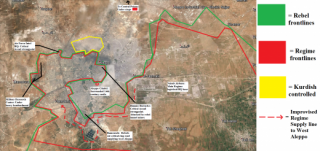Aleppo: Syria's Stalingrad?
The battle for Syria’s biggest city has entered a new phase. In the last few weeks, the situation in Aleppo has rapidly changed. Under a newly unified command, a new alliance of rebel groups now threatens to cut off the half the city that the Assad regime controls. This fight won’t be over soon, but for the first time since the start of the battle for this city in July 2012, one side may be gaining a clear upper hand.
The key to the recent rebel successes has been the formation of the “Ahl Al-Sham Operations Room”, a joint command of all the main rebel groups fighting in the city. Ahl Al-Sham commands some of the most powerful rebel units in Syria: Aleppo –based units of the Islamic Front (a coalition of Islamist rebel groups), the large, well-equipped Jaish Mujahideen, Jabhat al-Nusra, and the Chechen foreign fighter group Jaish al Muhajireen wa al-Ansar (JMA). The Syrian Revolutionary Front, a more secular-nationalist group of independent brigades, has been cooperating closely with Ahl Al-Sham command. Since the creation of the Ahl Al-Sham joint command in February 2014, the size and sophistication of rebel operations in the Aleppo theater has clearly increased. Combined with the expulsion of ISIS from the city, and the consequent end of debilitating tensions between ISIS and rebel groups, the strategic situation has improved for the rebellion in Aleppo.
The current rebel offensive began on 18 March, when Islamic Front rebels detonated explosives in a tunnel beneath the old Palace of Justice courthouse in Old Aleppo. The building had been turned into a fortress by regime troops, and with its destruction, the rebels quickly advanced into more of the city center. Then, on 21 March, several Islamist groups, including the Islamic Front and Jabhat al Nusra, mounted a surprise offensive over 100 km away from Aleppo, capturing the mountainous coastal district of Kessab. This predominately Christian and Alawite area is “home-turf” for the regime, and its mountain ridges overlook the port city of Latakia and the surrounding area, Assad’s heartland. With its core supporters suddenly under the threat of Grad rockets, the government was forced to draw reserves from around the country to mount counterattacks on the rebels in the highlands that have so far been largely fruitless.
Since the Kessab offensive sucked away the government’s reserves, the rebels have methodically advanced western Aleppo. The comparatively effective and dedicated Chechen jihadis of the JMA spearheaded assaults that culminated in the capture of Tel Shuwehneh on March 22, a strategic hill with commanding views over the outskirts of NW Aleppo. By April 17, steady rebel advances in the southwest of the city had captured most of the Ramouseh industrial district, and were pushing into once-secure regime areas like the Zahraa district in the west. The Ramouseh advance effectively cut off the regime-held western half of the city. Regime supporters admit that the government forces opposing the offensive were mostly poorly-motivated militiamen uneager to fight, held together by smaller numbers of Hezbollah fighters. At this point, rebels closed all crossing points between the two halves of the city, turned off electricity to western Aleppo and have sporadically cut off running water. The government has since managed to open an improvised, dirt-road supply line that skirts rebel-held territory around the south limit of the city, but it is precariously held.
The government’s position in western Aleppo depends on a series of “strongpoints”: large fortified complexes that dominate the areas around them with firepower. The rebels are attempting to slowly encircle and bombard these strongpoints into submission, one by one. In the northwest Aleppo, the Military Research Center and the Air Force Intelligence Headquarters are both surrounded on three sides and under constant fire. In the center of the city, the Hanano Military Barracks was attacked with another massive tunnel bomb, although the subsequent attempt to storm it was repulsed. If any of these falls, we could see a collapse of regime forces in that sector.
The patient encirclement of west Aleppo and the use of tunnels and siege tactics against government strongpoints recalls a battle for a medieval castle. It’s fitting that regime forces are surrounded inside the 14th century citadel at the city’s center. Like a medieval siege, this battle will be a race against time: can the rebellion starve out west Aleppo and seize the strongpoints before the government can find enough reinforcements from the rest of Syria to restore their supply lines? This strategy holds risks for the rebellion: the sieges-within-sieges of the strongpoints can take months to complete, and cutting off supplies to west Aleppo risks unfavorable comparisons to the regime’s free use of starvation as a weapon elsewhere. In the meantime, civilians continue to suffer terribly. Thousands were killed in since January by regime barrel bomb raids on eastern Aleppo, and rebel artillery has killed hundreds in government-held areas. The Ahl Al-Sham joint command issued a statement ordering its units to be more careful with their aim, but they’re not stopping the bombardment. With just a few more advances, the rebellion can impose a complete siege on west Aleppo. A successful siege would be the rebels’ biggest victory of the war.
Jack Mulcaire is a Center for the National Interest researcher.
Image provided by author.

